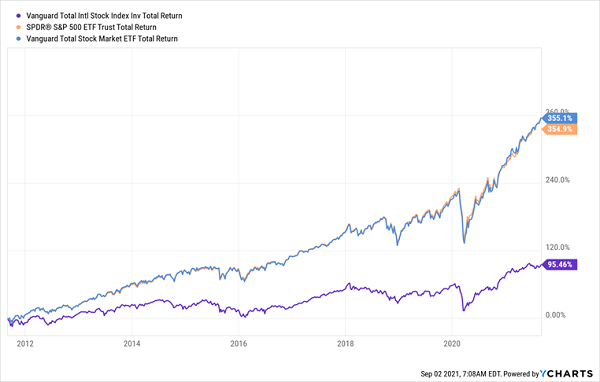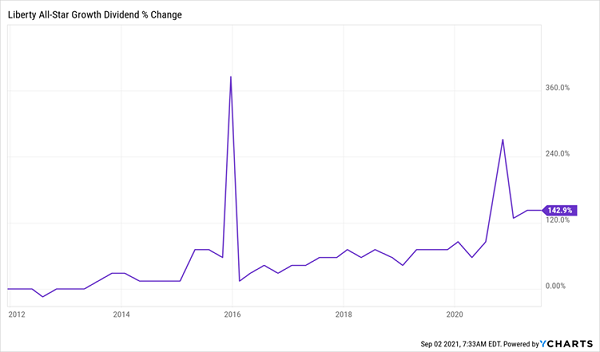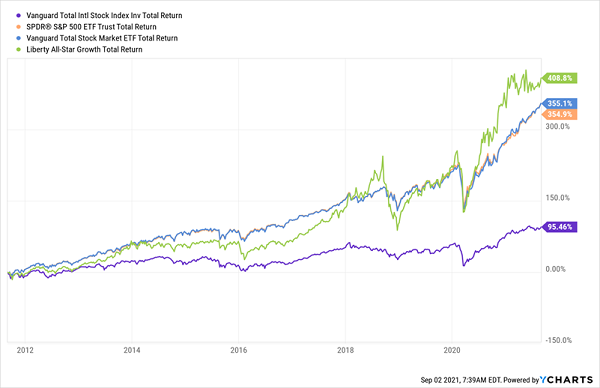It pains me when I see regular folks take the flawed “advice” to simply plow their money into an index fund and call it a day.
The biggest problem with this “strategy” is there’s basically no income: the SPDR® S&P 500 (NYSE:SPY) yields just 1.2% today, so you’d need a million-dollar portfolio just to generate a pathetic $12,000 a year in dividends!
Poverty-level income on a million bucks! That’s unacceptable. And it’s precisely why I’m going to share a much better option with you—yielding an mammoth 7.8%—in a moment.
I was thinking about the “lazy” ETF strategy recently when I was reading a blog post by fintech startup Acorns, which suggested going with an ETF like the Vanguard Total Stock Market Index Fund ETF Shares (NYSE:VTI), which invests in a whopping 3,935 US companies of all sizes, and combining it with the Vanguard Total International Stock Index Fund Investor Shares (VGTSX) for international exposure.
But here again, you’re not helping your income case: VTI yields the same as SPY: a mere 1.2%. Sure, VGTSX does a bit better, with a 2.3% yield, but that’s still well below inflation and pretty underwhelming given that many international companies yield more than their US counterparts.
And while you do get about as much diversification as it’s possible to get in just two funds, you pay for it in performance:
“Lazily” Diversified ETFs Deliver Predictable Result

As you can see above, despite all its diversification, VTI (in blue) only matched the S&P 500 (in orange) over the last decade, and was about equally as volatile. And allocating any money to the underperforming international-focused VGTSX would’ve dragged your return down further.
The key takeaway here is that while diversification is critical, it works best when done in an active way. Trying to do so through index funds inevitably exposes you to poor-performing companies. Also, ETFs’ broad portfolios mean you wind up holding way too many stocks, so gains in one are offset by losses in others.
This Actively Managed CEF (Yielding 7.8%!) Crushes Index Funds
Now let’s pivot to a much better solution: a closed-end fund (CEF) called the Liberty All Star Growth Closed Fund (NYSE:ASG).
ASG mainly focuses on the US, but it does hold some international stocks—about 4% of the portfolio. That’s about right for us, as US stocks tend to outperform over time, and ASG’s managers know full well that we’re getting plenty of “unofficial” international exposure through the US multinationals ASG holds, like Microsoft (NASDAQ:MSFT), Visa (NYSE:V) and Amazon.com (NASDAQ:AMZN).
Now let’s talk dividends: ASG yields an outsized 7.8% as I write this, and its dividend has soared in the last 10 years, with a couple big one-time payouts thrown in:
A True Dividend “Unicorn:” A 7.8% Payout That Soars
Now let’s move on to performance, because this is where ASG’s management team really shines: in the last decade, they’ve produced a total return that’s crushed that of every index fund we’ve talked about today—and by no small margin either!
ASG Humbles The ETF Competition
In other words, $100K invested in ASG 10 years ago would have grown to $508,800 today, including dividends. That’s $53,700 more than the same amount invested in VTI, our second-best performer. And because VTI’s dividend is so low, its investors would have had to rely almost entirely on paper gains for their return.
How Obsessing Over Fees Will Hurt Your Returns
That’s a great segue into the one bugbear many investors have with actively managed funds: high fees! It is true that ASG’s fees are higher than those of comparable ETFs: right now, it charges 1.2% of assets per year, compared to just 0.17% for VGTSX and a mere 0.03% for VTI!
But the returns I’ve shown you above are net of fees, so ASG is clobbering these funds with fees included. I don’t know about you, but I’d happily pay higher fees for a fund that’s delivering me an extra $53,700 a decade for every $100K invested!
Finally, ASG trades at a 2% discount to net asset value (NAV, or the value of the stocks in its portfolio) as I write this, so we’re getting a slight discount on its top-quality US stock holdings. These discounts are a quirk of the CEF structure—they simply don’t exist with ETFs, which are never on sale—and we can grab serious upside by grabbing a CEF at a discount and riding it to a nice premium. What’s more, ASG has seen premiums as high as 15% in the last year, so we can expect its slight discount to disappear soon, catapulting its price higher as it does!
Disclosure: Brett Owens and Michael Foster are contrarian income investors who look for undervalued stocks/funds across the U.S. markets. Click here to learn how to profit from their strategies in the latest report, "7 Great Dividend Growth Stocks for a Secure Retirement."
